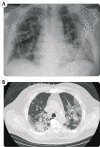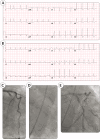A case report of unusually long episodes of asystole in a severe COVID-19 patient treated with a leadless pacemaker
- PMID: 33089056
- PMCID: PMC7454517
- DOI: 10.1093/ehjcr/ytaa238
A case report of unusually long episodes of asystole in a severe COVID-19 patient treated with a leadless pacemaker
Abstract
Background: Experience has been emerging about cardiac manifestations of COVID-19-positive patients. The full cardiac spectrum is still unknown, and management of these patients is challenging.
Case summary: We report a COVID-19 patient who developed unusually long asystolic pauses associated with atriventricular block (AV) block and atrial fibrillation who underwent leadless pacemaker implantation.
Discussion: Asystole may be a manifestation of COVID-19 infection. A leadless pacemaker is a secure remedy, with limited requirements for follow-up, close interactions, and number of procedures in a COVID-19 patient.
Keywords: Asystole; Atrial fibrillation; Atrioventricular block; COVID-19; Case report; Leadless pacemaker.
© The Author(s) 2020. Published by Oxford University Press on behalf of the European Society of Cardiology.
Figures





Similar articles
-
Atrioventricular Synchronous Pacing Using a Leadless Ventricular Pacemaker: Results From the MARVEL 2 Study.JACC Clin Electrophysiol. 2020 Jan;6(1):94-106. doi: 10.1016/j.jacep.2019.10.017. Epub 2019 Nov 11. JACC Clin Electrophysiol. 2020. PMID: 31709982 Clinical Trial.
-
Accelerometer-based atrioventricular synchronous pacing with a ventricular leadless pacemaker: Results from the Micra atrioventricular feasibility studies.Heart Rhythm. 2018 Sep;15(9):1363-1371. doi: 10.1016/j.hrthm.2018.05.004. Epub 2018 May 11. Heart Rhythm. 2018. PMID: 29758405
-
Tricuspid leaflet flail after Micra™ leadless pacemaker implantation: a case report.Eur Heart J Case Rep. 2022 Apr 15;6(6):ytac154. doi: 10.1093/ehjcr/ytac154. eCollection 2022 Jun. Eur Heart J Case Rep. 2022. PMID: 35775019 Free PMC article.
-
Atrioventricular synchronous leadless pacemaker: state of art and broadened indications.Rev Cardiovasc Med. 2021 Jun 30;22(2):395-401. doi: 10.31083/j.rcm2202045. Rev Cardiovasc Med. 2021. PMID: 34258906 Review.
-
Single-chamber leadless pacemaker for atrial synchronous or ventricular pacing.Pacing Clin Electrophysiol. 2020 Dec;43(12):1438-1450. doi: 10.1111/pace.14105. Epub 2020 Nov 8. Pacing Clin Electrophysiol. 2020. PMID: 33089883 Review.
Cited by
-
Paroxysmal Atrioventricular Block in a Relatively Young Patient with COVID-19.Intern Med. 2021 Aug 15;60(16):2623-2626. doi: 10.2169/internalmedicine.6237-20. Epub 2021 Jun 19. Intern Med. 2021. PMID: 34148946 Free PMC article.
-
Asystole in COVID-19 Infection: A Case Report.Cureus. 2021 Jul 12;13(7):e16346. doi: 10.7759/cureus.16346. eCollection 2021 Jul. Cureus. 2021. PMID: 34395127 Free PMC article.
-
Implantation of cardiac electronic devices in active COVID-19 patients: Results from an international survey.Heart Rhythm. 2022 Feb;19(2):206-216. doi: 10.1016/j.hrthm.2021.10.020. Epub 2021 Oct 26. Heart Rhythm. 2022. PMID: 34710561 Free PMC article.
-
A Case of Sick Sinus Syndrome With Prolonged Asystole Masquerading as a Transient Ischemic Attack.Cureus. 2023 Feb 25;15(2):e35465. doi: 10.7759/cureus.35465. eCollection 2023 Feb. Cureus. 2023. PMID: 36999106 Free PMC article.
-
Unusual Cardiac Presentation of COVID-19 with Significant Sinus Pauses.J Saudi Heart Assoc. 2020 Dec 24;32(4):450-453. doi: 10.37616/2212-5043.1226. eCollection 2020. J Saudi Heart Assoc. 2020. PMID: 33537189 Free PMC article.
References
-
- Goehler LE, Gaykema RP, Hansen MK, Anderson K, Maier SF, Watkins LR.. Vagal immune-to-brain communication: a visceral chemosensory pathway. Auton Neurosci 2000;85:49–59. - PubMed
Publication types
LinkOut - more resources
Full Text Sources
